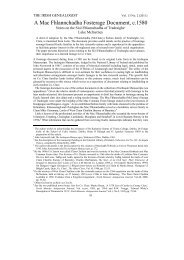Report Cover Vol I - Clare County Library
Report Cover Vol I - Clare County Library
Report Cover Vol I - Clare County Library
Create successful ePaper yourself
Turn your PDF publications into a flip-book with our unique Google optimized e-Paper software.
The <strong>County</strong> <strong>Clare</strong> Wetlands Survey Patrick Crushell & Peter Foss 2008<br />
_______________________________________________________________<br />
This category includes natural watercourses, or sections of these, that are actively eroding, unstable and<br />
where there is little or no deposition of fine sediment. Eroding conditions are typically associated with the<br />
upland parts of river systems where gradients are often steep, and water flow is fast and turbulent.<br />
Rivers in spate are included. For some rivers on the seaward side of coastal mountains, particularly in the<br />
west of Ireland, eroding conditions persist to sea level because of comparatively steep gradients over<br />
short distances, and high rainfall. Small sections of other lowland rivers may also be eroding where there<br />
are waterfalls, rapids or weirs. The beds of eroding/upland rivers are characterised by exposed bedrock<br />
and loose rock. Pebbles, gravel and coarse sand may accumulate in places, but finer sediments are rarely<br />
deposited. These rivers vary in size but are usually smaller and shallower than depositing/lowland<br />
rivers - FW2. Small mountain streams that dry out periodically can be included if an obvious channel<br />
persists or wetland plants are present.<br />
The unstable rocky channels of eroding/upland rivers usually support little vegetation cover. Submerged<br />
rocks and boulders may be colonised by aquatic mosses such as Fontinalis spp. and Racomitrium<br />
aciculare. Exposed rocks and wet shaded banks may also support extensive cover of lichens and<br />
liverworts. Higher plants are generally rare or absent except in places where fine sediments are trapped.<br />
Typical species include water-crowfoots (Ranunculus penicillatus, R. aquatilis), Alternate Water-milfoil<br />
(Myriophyllum alterniflorum) and the aquatic form of Bulbous Rush (Juncus bulbosus). Plant and animal<br />
communities of eroding/upland rivers are influenced by a range of factors including bedrock and<br />
substratum type, nutrient status, water force, water quality, shade and human impact. Habitat conditions<br />
also vary along different stretches of a river where there are riffles, runs, pools, waterfalls and<br />
backwaters.<br />
FW2 Depositing/lowland rivers<br />
This category includes watercourses, or sections of these, where fine sediments are deposited on the<br />
river bed. Depositing conditions are typical of lowland areas where gradients are low and water flow is<br />
slow and sluggish. These rivers vary in size but are usually larger and deeper than those above. In a<br />
natural state these rivers erode their banks and meander across floodplains. Because of this, most have<br />
been modified to some extent to control water flow, facilitate navigation or prevent flooding and erosion.<br />
Canalised or walled sections of rivers are included here, as are natural watercourses that have been<br />
dredged or deepened, and those with artificial earth banks. If channels have been excavated to divert<br />
water away from the main watercourse, these should be considered under canals - FW3. Tidal sections<br />
of rivers with brackish water influence are excluded (See tidal rivers - CW2). Rejuvenated sections of<br />
lowland rivers associated with rapids, waterfalls and weirs should be considered under eroding/upland<br />
rivers - FW1 if eroding conditions predominate.<br />
Plant and animal communities are influenced by numerous factors including substratum type, water<br />
force, nutrient status, water quality, channel size, water depth, human impact, disturbance and shade.<br />
Within a river channel there may be deep pools, backwaters, banks or mid-channel bars of gravel, sand<br />
or mud, in addition to vegetated islands and fringing reedbeds. The substratum of depositing/lowland<br />
rivers comprises mainly fine alluvial or peaty sediments. Vegetation may include floating and submerged<br />
aquatics, with fringing emergents in shallow water or overgrowing the banks. Floating aquatics can<br />
include water-lilies (Nuphar lutea, Nymphaea alba), pondweeds (Potamogeton spp.), water-starworts<br />
(Callitriche spp.) and Unbranched Bur-reed (Sparganium emersum). Tall emergents such as Common<br />
Club-rush (Schoenoplectus lacustris), Common Reed (Phragmites australis) and Yellow Iris (Iris<br />
pseudacorus) may also be present. Large areas of fringing reedbed should be considered under reed and<br />
large sedge swamps - FS1.<br />
FW3 Canals<br />
Canals are artificial linear bodies of water that were originally constructed for the purpose of navigation.<br />
They typically lack strong currents and any significant channel or bank erosion. This means that canals<br />
tend to have closer affinities with ponds than rivers. Canals can normally be distinguished from drainage<br />
ditches - FW4 by a combination of width and function. Channels that have been excavated to divert water<br />
away from the main watercourse are included in this category but canalised sections of rivers are<br />
excluded (See depositing/lowland rivers - FW2). Locks that are used to control water levels are<br />
considered as part of the canal habitat, but note that any built stone structures, including bridges and<br />
banks that are faced with stone, are excluded (See stone walls and other stonework - BL1). All<br />
canals require management and maintenance to keep them open and operational. They are readily<br />
colonised by aquatic plants and frequently support floating, submerged or emergent vegetation. Typical<br />
aquatics include water-milfoils (Myriophyllum spp.), water-lilies (Nuphar lutea, Nymphaea alba),<br />
Amphibious Bistort (Polygonum amphibium), bur-reeds (Sparganium spp.) and duckweeds (Lemna spp.).<br />
Canals with standing water are included here even if they are overgrown with swamp-like vegetation.<br />
Disused dry canals are excluded and should be classified on the basis of habitats they now support.<br />
107
















